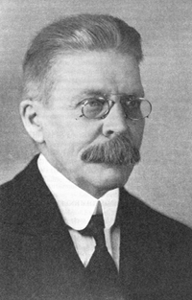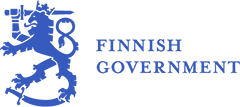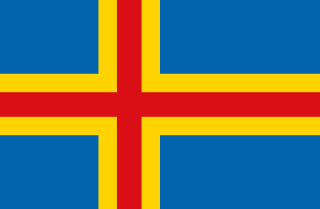
Aimo Kaarlo Cajander was the Prime Minister of Finland up to the Winter War.

The Centre Party, officially the Centre Party of Finland, is an agrarian political party in Finland.
The State Provincial Office on the Åland Islands represented the Finnish central government on Åland between 1918 and 2009. Due to its autonomy, it had somewhat different functions than similar offices in other Provinces of Finland. Generally a State Provincial Office was a joint regional authority of seven different ministries of the Government of Finland. In Åland the State Provincial Office also represented a set of other authorities of the central government, which in mainland-Finland has separate bureaucracies. On the other hand duties, which on mainland-Finland were handled by the provincial offices, were transferred to the autonomous government of Åland.
"Ålänningens sång" is the official anthem of the Åland Islands, an autonomous Swedish-speaking province of Finland. Adopted in 1922, the anthem's words are by John Grandell, and the music was composed by Johan Fridolf Hagfors. The song was first performed during the song festival in Mariehamn 1922. In Åland, the song is mostly sung on Midsummer's Eve and on the national day of Åland on 9 June. The song originally had four verses, but the third verse has been omitted for a long time when the song is sung and often when it appears in print.
The Constitution of Finland is the supreme source of national law of Finland. It defines the basis, structures and organisation of government, the relationship between the different constitutional organs, and lays out the fundamental rights of Finnish citizens, and individuals in general. The original Constitution Act was enacted in 1919, soon after Finland declared its independence in 1917. The current draft of the Constitution came into force on 1 March 2000.

The Finnish Government is the executive branch and cabinet of Finland, which directs the politics of Finland and is the main source of legislation proposed to the Parliament. The Government has collective ministerial responsibility and represents Finland in the Council of the European Union. In the incumbent Marin Cabinet, the Government comprises 19 ministers leading 12 ministries.

Heikki Ritavuori, was a Finnish lawyer, a politician from the National Progressive Party, a member of the Parliament of Finland and Minister of the Interior. He was the closest colleague of President K. J. Ståhlberg and was Minister of the Interior in J. H. Vennola's first and second cabinets from 1919 to 1922 for a total of 526 days. Heikki Ritavuori is a unique figure in Finland's political history because he is not remembered for his life's work, but instead for its end. Minister Ritavuori was shot dead at the door to his home in Helsinki in February 1922.

Karelia has appeared in philately several times; first as a breakaway republic from Soviet Russia in 1922, later when Eastern Karelia was occupied by Finland during the Continuation War of 1941 to 1944, and in the post-Soviet period when provisional stamps and cinderellas were issued. Additionally, there were Zemstvo stamps used in the early 20th century on the territory of the contemporary Republic of Karelia.

Juho Heikki Vennola was Professor of National Economics at the University of Helsinki, a member of the Parliament of Finland, and a politician from the National Progressive Party, who served as Prime Minister of Finland twice.
Parliamentary elections were held in Finland between 1 and 3 July 1922. The Social Democratic Party remained the largest in Parliament with 53 of the 200 seats. The caretaker government of Professor Aimo Cajander (Progressive), that President Kaarlo Juho Ståhlberg had appointed in June 1922, following the resignation of Prime Minister Juho Vennola (Progressive), remained in office until Kyösti Kallio formed an Agrarian-Progressive minority government in November 1922. Voter turnout was 58.5%.

The Treaty of Tartu was signed on 14 October 1920 between Finland and Soviet Russia after negotiations that lasted nearly five months. The treaty confirmed the border between Finland and Soviet Russia after the Finnish Civil War and Finnish volunteer expeditions in Russian East Karelia.

The East Karelian Uprising and the Soviet–Finnish conflict 1921–1922 were an attempt by a group of East Karelian separatists to gain independence from the Russian Soviet Federative Socialist Republic. They were aided by a number of Finnish volunteers, starting from 6 November 1921. The conflict ended on 21 March 1922 with the Agreements between the governments of Soviet Russia and Finland about the measures of maintenance of the inviolability of the Soviet–Finnish border. The conflict is regarded in Finland as one of the heimosodat – "Kinship Wars".
Lantråd is the title of the Head of Government of the Åland Islands in Finland. The person holding the office leads its regional government.
Juho Vennola's second cabinet was the sixth Government of Republic of Finland. Cabinet's time period was April 9, 1921 – June 2, 1922. It was a minority government. Minister of the Interior Heikki Ritavuori was assassinated in Helsinki February 14, 1922 in front of his home door. This was the only assassination in the history of independent Finland.
Kyösti Kallio's first cabinet was the eighth Government of the Republic of Finland. The cabinet's time period was November 14, 1922 – January 18, 1924. It was minority government.

Province of Åland was a province of Finland from 1918 to 2009.

The Revolutions of 1917–1923 was a revolutionary wave that included political unrest and revolts around the world inspired by the success of the Russian Revolution and the disorder created by the aftermath of World War I. The uprisings were mainly socialist or anti-colonial in nature. Some socialist revolts failed to create lasting socialist states. The revolutions had lasting effects in shaping the future European political landscape, with for example the collapse of the German Empire and the abdication of the German Kaiser.

Stepan Maximovich Petrichenko was a Russian revolutionary, an anarcho-syndicalist politician, the head of the Soviet Republic of Soldiers and Fortress-Builders of Nargen and in 1921, de facto leader of the Kronstadt Commune, and the leader of the revolutionary committee which led the Kronstadt rebellion of 1921.

The Declaration and Treaty on the Formation of the Union of Soviet Socialist Republics officially created the Union of Soviet Socialist Republics (USSR), commonly known as the Soviet Union. It de jure legalised a political union of several Soviet republics that had existed since 1919 and created a new federal government whose key functions were centralised in Moscow. Its legislative branch consisted of the Congress of Soviets of the Soviet Union and the Central Executive Committee of the Soviet Union (TsIK), while the Council of People's Commissars composed the executive.

The Republic of Uhtua was an unrecognized state, with the focus of a state led by Finns. It existed from 1919 to 1920, created out of five Volosts in the Kemsky Uyezd of the Arkhangelsk Governorate, now in the Republic of Karelia. The capital of the republic was the village of Uhtua.















